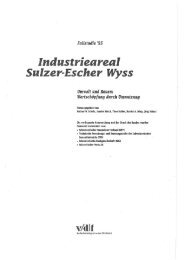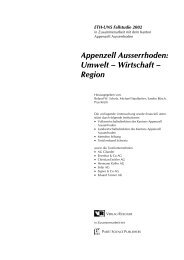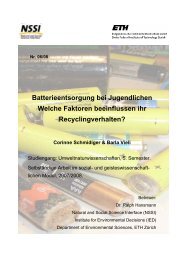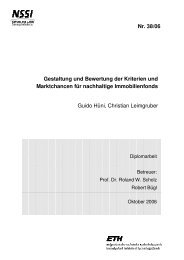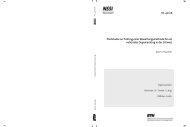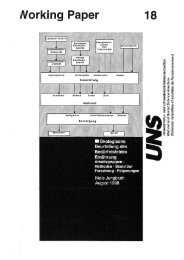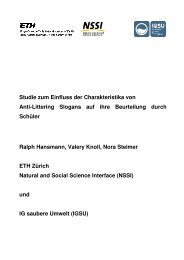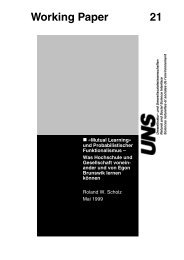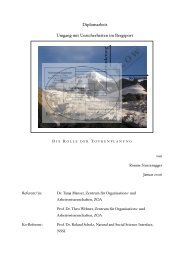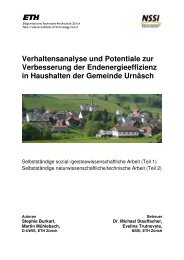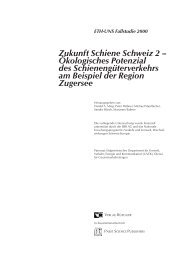The Paradigm of Human-Environment Systems - Natural and Social ...
The Paradigm of Human-Environment Systems - Natural and Social ...
The Paradigm of Human-Environment Systems - Natural and Social ...
Create successful ePaper yourself
Turn your PDF publications into a flip-book with our unique Google optimized e-Paper software.
<strong>The</strong> <strong>Paradigm</strong> <strong>of</strong> <strong>Human</strong>-<strong>Environment</strong> <strong>Systems</strong><br />
To underst<strong>and</strong> societal learning, the historical development <strong>of</strong> explanatory cause <strong>and</strong> ef-<br />
fect models is most intriguing <strong>and</strong> insightful <strong>and</strong> can be used to document the learning that<br />
occurs at different hierarchy levels <strong>of</strong> the human system. <strong>The</strong> ancient scientists had to answer<br />
the question <strong>of</strong> whether or not the Black Death was caused by the devil, witches, fungi or small<br />
animals. Viruses <strong>and</strong> bacteria were not accessible with their instruments. <strong>The</strong> Black Death was<br />
associated with the devil <strong>and</strong> priests <strong>and</strong> medical doctors were not obliged to support sick people.<br />
<strong>The</strong> scientific explanation resulted in the “Miasma theory” (Zweifel, 1989) where the belief<br />
was that bad odors transmitted the disease. <strong>The</strong>se odors originated both from fecal matter <strong>and</strong><br />
rottenness <strong>and</strong> could also contaminate soils. <strong>The</strong>refore, avoiding bad odors was seen as the<br />
solution for eliminating the epidemic. In the terminology <strong>of</strong> the PSM we speak <strong>of</strong> goal formation<br />
<strong>of</strong> societal agents. In the course <strong>of</strong> experiencing the Black Death, society developed strate-<br />
gies such as road <strong>and</strong> harbor blockades, quarantines <strong>and</strong> disinfections using lime, bases <strong>and</strong><br />
sulfur (Brockhaus, 1865). <strong>The</strong> assumption was that these measures helped to suppress the p<strong>and</strong>emic<br />
character <strong>of</strong> pest. Today it is known that the Black Death is caused by a bacterium<br />
Yersinia Pestis (detected by the French physician Yersin in 1894) <strong>and</strong> flourishes in humid envi-<br />
ronments when temperatures are between 20 <strong>and</strong> 24 degrees Celsius. <strong>The</strong>se are the optimal<br />
conditions <strong>of</strong> reproduction <strong>of</strong> rat fleas (Xenopsylla cheopes), which are the transmitter <strong>of</strong> the<br />
disease. In addition, the population dynamic cycle <strong>of</strong> rats, as part <strong>of</strong> the environmental dynamics,<br />
seems to be relevant 3 . Floe bits transmit the bubonic plague, the milder form <strong>of</strong> the Black<br />
Death. If not treated it might develop into “lung pest”, which is an airborne infection.<br />
With respect to the framework provided in Figure 1, three lessons can be learned:<br />
<strong>Human</strong> species, as an agent, altered not only the human system, but also affected the<br />
environmental system, represented by the growth <strong>of</strong> the rat <strong>and</strong> flea populations. <strong>The</strong> outbreak<br />
<strong>of</strong> the Black Death is, thus, considered a secondary long-term feedback loop <strong>of</strong> human action.<br />
<strong>The</strong> human learning related to the underst<strong>and</strong>ing <strong>of</strong> environmental feedback loops<br />
shifted from "mystic <strong>and</strong> pre-logical" (e.g., Black Death is caused by witches, see also primitive<br />
man's collective representations, Levy Bruhl, 1932) to complementary logical, cause-impact<br />
schemes (e.g., miasma theory). <strong>The</strong> latter referred to various potential, but invalid assumptions<br />
<strong>and</strong> conclusions about the genesis <strong>of</strong> the disease.<br />
As we know from propositional logic, truth (right action) may result from false assumptions<br />
4 . In this case various means <strong>of</strong> disinfections <strong>and</strong> hygiene reduced the spread <strong>of</strong> the Black<br />
Death by a providing less attractive environment for rats.<br />
3 Within the time <strong>of</strong> reproduction, the living conditions or rats are crowded, forcing them to search for food outside<br />
their normal environment. <strong>The</strong>y intrude the human settlements <strong>and</strong> the fleas can more readily transmit the Black<br />
Death.<br />
4 This aspect refers to the principle <strong>of</strong> probabilistic stabilization in Brunswik’s theory <strong>of</strong> probabilistic functionalism<br />
(Brunswik, 1952), as wrong behavior can be occasionally rewarded.<br />
ETH-UNS Working Paper 37 13



